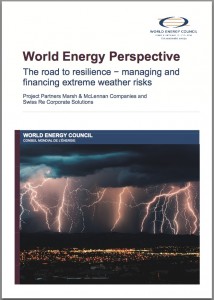World Energy Council: Energie-infrastructuur moet veerkrachtiger
5 oktober 2015 – Energie-infrastructuur krijgt steeds meer te maken met extreem weer. Het energiesysteem moet niet meer gericht zijn op het voorkómen van uitval, maar op slim reageren op uitval.
De World Energy Council concludeert dat in het rapport ‘The road to resilience – managing and financing extreme weather risks’. Het rapport is de eerste in een serie rapporten over het omgaan met nieuwe risico’s en wordt op 23 oktober gepresenteerd op het World Energy Congress in Istanbul, op een vergadering van de energieministers van de G20.
 Energiesystemen krijgen steeds vaker te maken met steeds extremere weersomstandigheden. Ze moeten daardoor hogere pieken in de energievraag aankunnen en de infrastructuur kan door bijvoorbeeld orkanen of overstromingen beschadigd raken.
Energiesystemen krijgen steeds vaker te maken met steeds extremere weersomstandigheden. Ze moeten daardoor hogere pieken in de energievraag aankunnen en de infrastructuur kan door bijvoorbeeld orkanen of overstromingen beschadigd raken.
Uit de managementsamenvatting van het rapport
‘(…) The number of extreme weather events increased more than 4 times from 38 in 1980 to 174 events in 2014. Severe convective storms’ contribution to overall insured losses (last 5 years compared to last 20 years) alone has increased to over 40%. Many more events are expected in the future, driven by the increase in global average temperature. Extreme hot and cold temperatures will raise overall energy demand and strain peak capacity. The energy supply also faces reduced efficiency of thermal plants, cooling constraints on thermal and nuclear plants and increased stress on transmission and distribution (T&D) systems. More extreme events such as tropical storms, droughts or floods may not only impact energy production and revenue streams, but also the equipment itself.(…)’
Omdat de extreme weersomstandigheden toenemen in aantal en ernst, is het zaak het management en de financiering van energie-infrastructuur aan te pakken, zo stelt de WEC. De infrastructuur moet niet meer zozeer worden ingericht om uitval te voorkomen. Het energiesysteem moet veerkrachtiger worden, slimmer, zodat het beter op extreme omstandigheden kan reageren en bij uitval sneller weer in bedrijf kan worden gesteld.
Christoph Frei, Secretaris-Generaal van de WEC in een bericht van de WEC
‘(…) “We are on a path where today’s unlikely events will be tomorrow’s reality. We need to be smarter and imagine the unlikely. Traditional ‘Fail–Safe’ systems, based on predicted events, no longer operate in isolation. New ‘Safe-Fail’ systems, which recognise that unexpected weather events are occurring and that systems which go down need smarter, not stronger, solutions. This new approach is essential if we are to cope with new weather patterns and phenomena such as the more powerful El Niño currently experienced in many parts of the world. (…)’
Om die overgang in het energiesysteem te financieren, zijn ook nieuwe regels en financiële instrumenten nodig.
Uit het persbericht van WEC
‘(…)
- Weather derivatives that complement traditional re-insurance solutions
- Catastrophe bonds that transfer peak risks to capital markets
- Adaption bonds which ensure funds go towards resilience measures, particularly in vulnerable areas.(…)’
Bronnen
World Energy Council, 30 september 2015: Resilient energy needs smarter not just stronger solutions: Safe-Fail not Fail-Safe
World Energy Council, rapport – managementsamenvatting, september 2015: The road to resilience – managing and financing extreme weather risk (pdf)
World Energy Council, rapport, september 2015: The road to resilience – managing and financing extreme weather risk (pdf)



